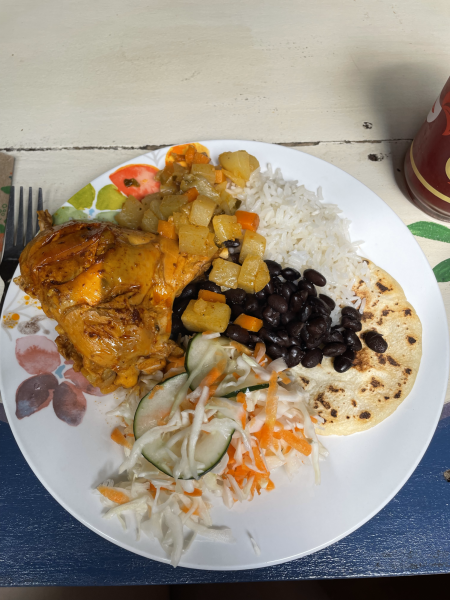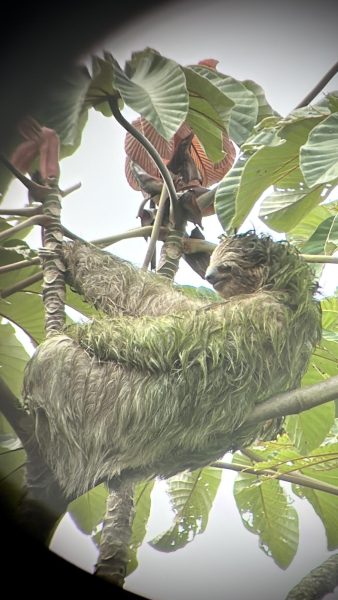Ten female students from Leominster High School traveled with Spanish teacher, Sarah Piragis and Vice Principle Leah Burns to Costa Rica during February vacation.
In 1502 Christopher Columbus discovered and named Costa Rica, Rich Coast, due to it’s beautiful, lush, green color of plants that grow because of the tropical climate. It was not until 1561 when Juan de Cavallon from Spain was able to lead the first colonizers to live in Costa Rica.
1987 is the first year that the number of tourists coming to visit Costa Rica became noticeably higher as the number of tourists flew to be above 1.03 million. By 2023 there were 2.47 million tourists recorded in Costa Rica.
Just about the size of West Virginia, Costa Rica is a smaller country found in the strip of Central America, boarded by Panama in the south and Nicaragua in the north.
The students spent a week traveling to different areas in Costa Rica such as Arenal in La Fortuna, Monte Verde, and Pontarenas, before going back to San Jose.
The girls began their trip in San Jose, where they were picked up by their Explorica tour guide, Hugo and bus driver, Miguel.
After spending just one night in San Jose, the girls loaded into the bus and began their journey to La Fortuna and the volcano, Mount Arenal, that is located there.
About halfway to their destination, the bus stopped at a small restaurant where the owner took the group through her gardens and they learned about a variety of different crops that are grown in Costa Rica and can commonly be found in the dishes that are served there.

Many buildings in Costa Rica are open with no walls, and this restaurant was no different. There, the girls made their own tortillas and enjoyed a meal of rice, squash, chicken, beans, salad, and of course; their tortillas.
After finishing their meal the girls watched a cultural folk dance where girls with long skirts twirled and spun, looking like birds in flight.
Before getting back on the bus, Hugo set up his telescope and they saw their first sloth.

The group traveled the rest of the way to La Fortuna where they hiked around the base of the volcano, Arenal.
La Fortuna gained their name of fortune after the volcano erupted and destroyed all the other towns in the area except for La Fortuna.
La Fortuna is an area of Costa Rica that is in the rainforest and it is known to be rainy, misty, and dark.
While hiking through this section of rainforest, they saw howling monkeys, toucans, woodpeckers, and other species of birds and lizards.
After the hike they went to a new hotel that is known for it’s carbon footprint of nearly zero, called Villas Eco Arenal; where they enjoyed dinner and rest.
The next day the group got up bright and early in the pouring rain, to Kayak in Lake Arenal before continuing on to hike through a nature preserve with hanging bridges.
Costa Rica closed all of their zoos around 2013, but they have many nature preserves, National Parks, and animal rehabilitations centers.

The group hiked through a nature preserve where they saw more howling monkeys and walked across a series of bridges that hang hundreds of feet over the rainforest.

After getting severely wet, the group traveled back to La Fortuna where they enjoyed a hot springs resort. Due to the active volcano so close, there is a large amount of geothermal activity around Arenal. One example of this activity is the hot springs.
Then, they traveled back to the Villas for dinner and the rest of the night.
Day four was another travel day and they packed back into the bus and headed for Monteverde, green mountains.
Monteverde was not quite as rainy as La Fortuna, but instead known for the mist that hangs in the air.
The girls stopped for a horseback riding excursion through the hills before arriving at their hotel.

The next day the girls woke up early to go on a ziplining canopy tour.
Ziplining is a popular tourist attraction in Costa Rica, and it is easy to see why. The girls zipped right through a rainbow and enjoyed the magnificent views.
After ziplining, Hugo led them through the Santa Elena Biological Reserve and they learned more about the soft root systems of the rainforest and how the vegetation survives, fighting for sunlight.
The girls had their last dinner in Monteverde, and the next morning they awoke bright and early to begin the long drive to Puntarenas for their second to last hotel.
Along the way to Puntarenas, Hugo stopped the van to see the views of the rolling hills they were leaving and say goodbye to the temperate climate.
On this travel day, the group stopped at the Natuwa Wildlife Sanctuary to plant a tree. The Natuwa Sanctuary opened in 1994 and has a goal of educating the public on the harm of domesticating wild animals such as macaws and monkeys.
Groups that go to visit the sanctuary are invited to plant trees on the edge of the reservation to help promote the growth of the wildlife. The sanctuary provides safety for animals that will never be able to be released to the wild again, but they also allow wild animals in the sancturay as well.

Natuwa built monkey bridges across the road so that monkeys would be able to travel safely from the wild forest to the sanctuary forest. The monkey bridges are ropes that go across the road so the monkeys can swing across them instead of using power lines or risking walking across and being hit by a car.
The girls helped plant their tree and then took a tour throughout the sanctuary and they saw jaguars, ocelots, white face monkeys, spider monkeys, macaws both green and scarlet, and many other animals.
After boarding the bus again, the group traveled to a crocodile sunset safari. One the safari they girls saw 24 different species of birds along with lizards and of course, crocodiles.

They watched the sunset over the estuary before going back to the bus and arrived at their hotel in Puntarenas. The next day, they visited Manuel Antonio National Park where they hiked through the rainforest and saw sloths, a boa constrictor and many other creatures before arriving at the beach where they swam for hours and Hugo protected their things from the white face monkeys who were fond of thievery.


After the beach day they traveled back to the hotel and swam in the pool for hours before having dinner and going to sleep.
The next day was another travel day from Puntarenas back to where they began in San Jose. They stopped at the Sarchi Craft Village, where they saw the worlds largest ox cart, a significant symbol to the culture in Costa Rica.
The ox cart is important in Costa Rica as it represents the hard work that went into the creation off the civilization and the cultivation of their largest crop, coffee. The group took a tour of the factory where ox carts are built and artisans hand paint trinkets and souvenirs for the shop.

After shopping for some time, the group traveled to their final hotel where they got dressed up for their final dinner in Costa Rica. They traveled to a restaurant called Mirador Ram Luna which was situated atop a hill and overlooked the lights of San Jose. The girls enjoyed their dinner and then were treated to another cultural folklore dance.

It was a special way to end their week in Costa Rica.
They got up early the next morning to have the hotel breakfast before Miguel and Hugo dropped them at the airport for a sad goodbye.
If you are looking for a place to take a trip where you can explore a multitude of climates and see hundreds of species of animals while also soaking up the sun, Costa Rica is for you!



Tyler Witzgall • Mar 8, 2024 at 11:51 am
Amazing article sick vic!!! You have really sold this Costa Rica trip, and now I want to go myself.